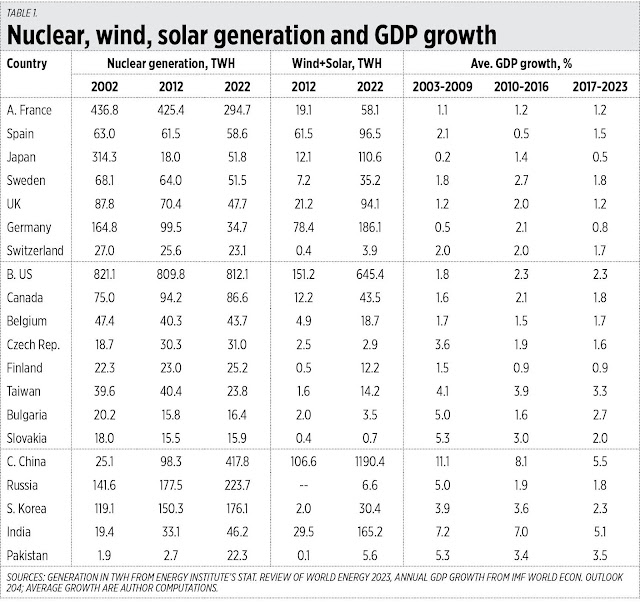On nuclear energy, LFSCOE, and the red-yellow alerts
April 23, 2024 | 12:02 am
My Cup of Liberty
By Bienvenido S. Oplas, Jr.
https://www.bworldonline.com/opinion/2024/04/23/589739/on-nuclear-energy-lfscoe-and-the-red-yellow-alerts/
Since I will cover three energy topics in this piece, I will focus on the data and shorten the discussion.
RISE IN NUCLEAR POWER USE AND HIGH GROWTH
Nuclear energy — having the highest energy density, a high capacity factor, and least cost of fuel per kilowatt hour (kwh) of generation — shows that it can help sustain high growth of an economy, among various factors and drivers of economic growth. This is shown in the cases of China, South Korea, India, and Pakistan. Meanwhile, adding more intermittent wind and solar power contributes to slow growth, if not degrowth and deindustrialization. Clear cases of this are shown by the United Kingdon and Germany.
For Table 1, I have grouped the countries into Group A (denuclearizing countries), Group B (fluctuating use), and Group C (countries with rising nuclear energy use).
LEVELIZED FULL SYSTEM COST OF ELECTRICITY
I tackle this since I went through a study, “Levelized Full System Costs of Electricity” (LFSCOE) by Robert Idel, in Energy 259 (2022), published by Elsevier.
The common measurement of economic and energy efficiency of various power sources is the Levelized Costs of Electricity (LCOE) which summarizes different ratios of fixed to variable costs into a single cost metric. But this measurement does not consider the intermittency (or instability, unreliability) and non-dispatchability on demand of renewables. So, a more realistic measurement was created, the LFSCOE.
Under LCOE (where storage cost and backup power are not incorporated), solar and wind power appears “cheap,” only $36-$40/Megawatt hour (MWh). But when storage and related costs are included, the cost of solar jumps to $1,380/MWh in Germany and $413/MWh in Texas.
The capacity factor or actual electricity generation per megawatt of installed power are lowest for solar (only 1.5% in Germany and 10.4% in Texas and hence, unreliable if not dangerous for energy-intensive industries and sectors (see Table 2).
This further explains why countries that added more wind and solar power in their grid are experiencing crawling or stunted growth. Like the United Kingdom and Germany.
YELLOW AND RED ALERTS
Last week, from April 16-18, the Luzon and Visayas grids experienced a prolonged series of yellow and red alerts. The main reason was high electricity demand due to extremely hot weather and cloudless skies almost daily, and the decline of the power supply due to the unscheduled shutdowns of several power plants plus the de-rating of other plants like hydro. In Table 3 are the relevant numbers from the Independent Electricity Market Operator of the Philippines (IEMOP).
In a press conference last Friday, April 19, Energy Secretary Raphael EM Lotilla thanked the various energy stakeholders and the public “for their cooperation in avoiding power interruptions despite the red and yellow alerts that were declared (due) to thin reserves.” He reiterated the need for energy conservation by consumers, mentioned the role of the Interruptible Load Program (ILP) by Meralco and many other distribution utilities and electric cooperatives to augment overall power supply, and the possibility of rain seeding in coordination with the Agriculture Department.
The Energy Regulatory Commission (ERC) also released a statement on April 18 where Chairperson Monalisa Dimalanta emphasized the importance of having “a steady and adequate power supply to meet consumer demands and the grid’s regulating requirements… We have directed power plant operators to submit to the Commission their estimated timelines for the resumption of their operations, and we will continue to monitor their timely compliance.”
The ghost of big blackouts of 1990-1992 continues to hound us after more than three decades. This is not good. As a developing country aspiring to industrialize and have sustained growth, we should focus on high-growth targets, not high-renewables targets. All our efforts to attract foreign and domestic investments (FDIs) will be endangered if investors see the dangers of regular yellow and red alerts.
-----------
See also:
BWorld 697, Philippine Energy Plan won’t ensure security
BWorld 698, Improving state revenue and boosting FDIs
BWorld 699, On oil economics and Philippines vital statistics



No comments:
Post a Comment